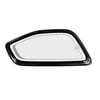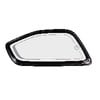Help with Laser Protective Eyewear specifications:
Protection
Back to Top
|
|
| ||
| Primary Wavelength | Primary wavelength is the first wavelength interval (lowest to highest order, unless otherwise specified by the manufacturer), associated with a specific optical density (O.D.), of the functional (non-alignment) laser as measured in nanometers. | ||
| Search Logic: | User may specify either, both, or neither of the limits in a "From - To" range; when both are specified, matching products will cover entire range. Products returned as matches will meet all specified criteria. | ||
| Transmission (V.L., %) | Optical transmission property of the light medium material, expressed as a percentage. | ||
| Search Logic: | User may specify either, both, or neither of the limits in a "From - To" range; when both are specified, matching products will cover entire range. Products returned as matches will meet all specified criteria. | ||
Laser Technology
Back to Top
|
|
| ||
| Your choices are... | |||
| Alexandrite | Synthetic alexandrite is used as an active or gain medium within a laser. | ||
| Argon | Argon lasers are a type of ion laser using a noble gas as the active or gain medium. | ||
| CO2 | Carbon dioxide lasers are a type of ion laser using a noble gas as the active or gain medium. | ||
| Diode | Diode lasers are a type of ion laser using a noble gas as the active or gain medium. | ||
| Dye | Dye lasers are a type of laser using an organic dye as the active or gain medium. | ||
| Er:YAG | Er:YAG lasers are solid state, and use erbium-doped yttrium aluminum garnet for the active or gain medium. | ||
| Erbium | Erbium lasers contain optical grade silica-glass fibers, doped with erbium, for the active or gain medium. | ||
| Excimer | Excimer lasers, sometimes called "exciplex", are a type of ultraviolet laser that typically uses a combination of an inert gas and a reactive gas for the active or gain medium. | ||
| GaAs | Gallium arsenide lasers use GaAs as the active or gain medium (a semiconductor material) for a near infrared, light emitting diode. | ||
| HeCad | Helium cadmium lasers are a type of metal-vapor laser often used in printing and typesetting applications (for example, paper currency printing), and for scientific research. | ||
| HeNe | Helium neon lasers are a type of gas laser where a mixture of helium and neon gases is used as the active or gain medium. | ||
| Holmium | Holmium lasers are a type of solid state laser using holmium as the active ion in the active or gain medium. | ||
| Krypton | Krypton lasers are a type of gas laser using krypton as the active ion in the active or gain medium. | ||
| KTP | KTP is a laser technology, used in medical applications, in which the working beam is generated when a neodymium:YAG laser is directed through a Potassium Titanyl Phosphate ("KTP") frequency doubling crystal, to produce a resulting beam in the green visible spectrum (520-570 nanometers). An example use is in human endoscopy procedures. | ||
| Nd:YAG | Neodymium-doped yttrium aluminum garnet is a crystal used as a lasing medium for solid state lasers. | ||
| Near IR | A near infrared (NIR) laser is a laser with an output wavelength in the range of 800 - 1,500 nanometers. Applications of NIR lasers include forensic analysis of polymers and other materials, and applied spectroscopy. | ||
| Ruby | Ruby lasers are a type of solid state laser using synthetic ruby as the active or gain medium. | ||
| Ti:Sapphire | Titanium-sapphire lasers are a type of tunable, solid-state laser using a crystal of sapphire doped with titanium ions as the active or gain medium. | ||
| UV | Ultraviolet (UV) lasers have applications in industry (laser engraving and photolithography), medicine (dermatology and keratectomy), free-air secure communications and computing (optical storage). They can be made by applying frequency conversion to lower-frequency lasers, or from Ce:LiSAF crystals (cerium doped with lithium strontium aluminum fluoride), a process developed in the 1990s at Lawrence Livermore National Laboratory. | ||
| Search Logic: | All products with ANY of the selected attributes will be returned as matches. Leaving all boxes unchecked will not limit the search criteria for this question; products with all attribute options will be returned as matches. | ||
Type
Back to Top
|
|
| ||
| Type | |||
| Your choices are... | |||
| Spectacles | Glasses are frames bearing lenses worn in front of the eyes for vision correction. Frames are commonly made from metal or plastic, and lenses from glass or a plastic like polycarbonate. | ||
| Goggles | Goggles are a form of protective eyewear that usually enclose or protect the eye socket area to prevent particulates, water, or chemicals from coming into contact with the eyes. They are often worn when using power tools such as drills or chainsaws, to prevent flying debris from damaging the eyes. | ||
| Over Glasses | Over glasses are devices designed to attach to eyewear directly in front-of (or behind) the primary optical media. This protects both eyes, and provides additional eye protection related to dangerous light-emitting sources. | ||
| Side Shields / Wraparound | Side shields / wraparound glasses or spectacles are a type of eyewear that include peripheral devices that either attach to or are integrated into (via factory molding) the primary, forward-facing eyewear, and provide protection at the side of the eye sockets, closing off entry points for flying debris, liquids, or harmful light. | ||
| Specialty / Other | Other head-protection type. | ||
| Search Logic: | All products with ANY of the selected attributes will be returned as matches. Leaving all boxes unchecked will not limit the search criteria for this question; products with all attribute options will be returned as matches. | ||
Features
Back to Top
|
|
| ||
| Your choices are... | |||
| Prescription / Bifocals | Prescription / bifocal products offer a user-specific feature authorized by the user's medical doctor, such as lens correction, to assist the user in performing work. | ||
| Other | Other unlisted feature. | ||
| Search Logic: | All products with ANY of the selected attributes will be returned as matches. Leaving all boxes unchecked will not limit the search criteria for this question; products with all attribute options will be returned as matches. | ||
Industry
Back to Top
|
|
| ||
| Your choices are... | |||
| Aerospace | Aerospace manufacturing is a high technology industry that produces "aircraft, guided missiles, space vehicles, aircraft engines, propulsion units, and related parts," according to the Bureau of Labor Statistics of the United States Web site. Most of the industry is geared toward governmental work. For each original equipment manufacturer (OEM), the US government has assigned a CAGE code. These codes help to identify each manufacturer, repair facilities, and other critical after market vendors in the aerospace industry. | ||
| Automotive / Vehicle Manufacturing | The automotive industry is the industry involved in the design, development, manufacture, marketing, and sale of motor vehicles. | ||
| Building and Construction | In the fields of architecture and civil engineering, construction is a process that consists of the building or assembling of infrastructure. | ||
| Cleanroom | The cleanroom industry includes companies involved with manufacture and design of low-particulate environments for industrial production (for example, semiconductor fabrication rooms). | ||
| Fire | The fire products industry includes companies who manufacture and/or design products used in industries where combustion is present, such as firefighting. | ||
| Foundry | The foundry industry includes companies that design and/or manufacture products used for protection against heat and other dangers in the production of metal castings. | ||
| Laboratory | The laboratory industry includes public, private, and quasi-public companies and entities that perform product, theoretical, and other testing (mechanical, electrical, etc.) of various kinds. This industry often employs technicians, engineers, and scientists. The end product of the laboratory is primarily data. | ||
| Medical | Medical industries that develop, manufacture, market, and/or distribute health-related products or provide health care services. Examples include hospitals, nursing homes, HMOs, medical product suppliers, medical equipment and medical device makers, and medical laboratories. | ||
| Military / Government | The military / government industry includes federal, state, county, local and other-level government agencies or government-related establishments, including military and public service (police, fire, volunteer) entities. | ||
| Mining | The mining industry includes companies involved with mineral extraction processes. | ||
| Pharmaceutical | Pharmaceutical companies research, develop, produce, and sell chemical or biological substances for medical or veterinary use, including prescription, generic and OTC drugs; vitamins and nutritional supplements; drug delivery systems and diagnostic substances; and related products, equipment, and services, including distribution and wholesale. | ||
| Utilities | The utility industry includes public, private, and quasi-public companies and entities involved with the supply of electric, gas, water, and other forms of energy, to homes and businesses. | ||
| Other | Other unlisted industry. | ||
| Search Logic: | All products with ANY of the selected attributes will be returned as matches. Leaving all boxes unchecked will not limit the search criteria for this question; products with all attribute options will be returned as matches. | ||
Application
Back to Top
|
|
| ||
| Application | |||
| Your choices are... | |||
| Chemical / Hazmat | Chemical / hazmat protective products protect against injury from skin or eye contact with hazardous liquid or solid substances. Examples include splashing acids or solid lead materials dangerous for skin contact. | ||
| Electrical | Electrical protective products provide protection against electricity, high voltage, and other sources of electric shock. | ||
| Radiation / Nuclear | Radiation / nuclear protective products offer a degree of safety from subatomic particles emitted by an atom as it changes from a higher energy state to a lower energy state. | ||
| Welding | Welding protective products are used for safety against sparks, arc-welding related UV light frequencies, and other harmful emissions resulting from use of welding equipment. | ||
| X-Ray | X-ray protective products are used for safety against electromagnetic radiation with wavelengths between 10 to 0.01 nanometers. | ||
| Other | Other unlisted application. | ||
| Search Logic: | All products with ANY of the selected attributes will be returned as matches. Leaving all boxes unchecked will not limit the search criteria for this question; products with all attribute options will be returned as matches. | ||


